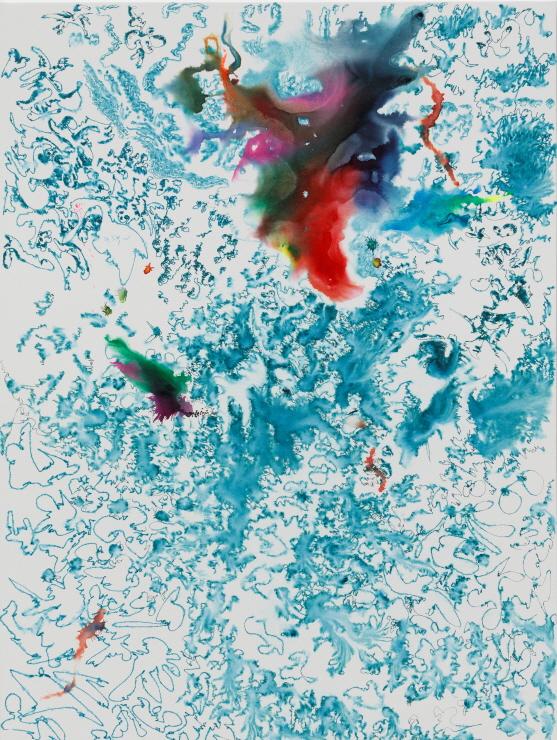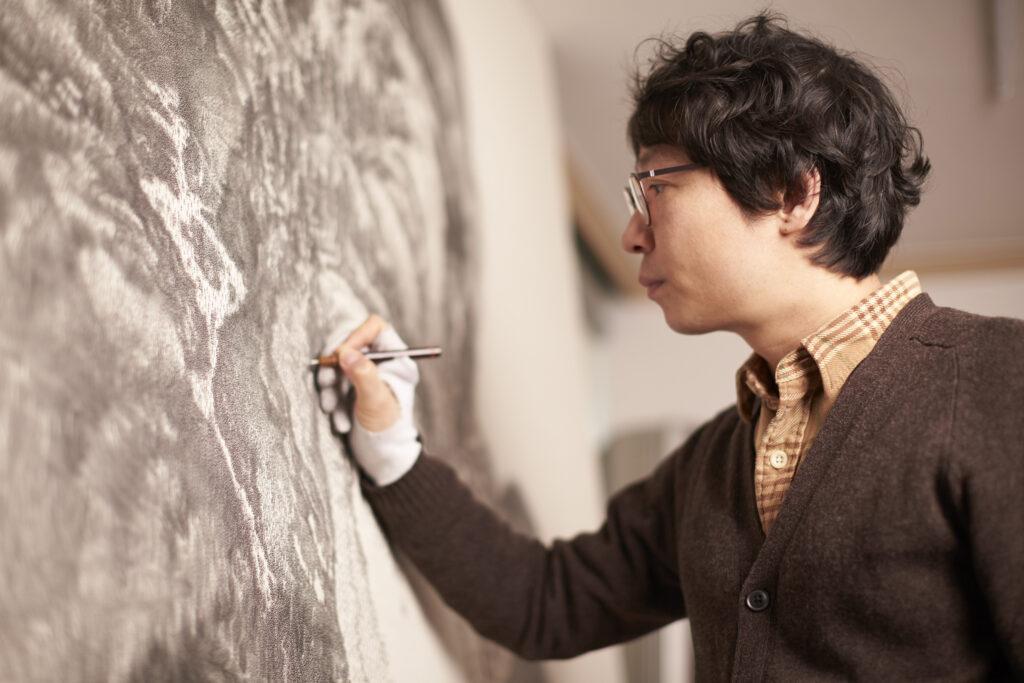YOO
Seungho has created diverse works with characters and images. On display at
this exhibition are his recent pieces that are an extension of his previous
works. Reviewing his previous pieces and their context will be guides for
grasping the current world of his art. His work is classified not by specific
series but by exhibition titles, and any classification by period is of no
significance because he has done several works simultaneously. His works can be
reviewed and classified in a few typical styles.
The
first style comes from the series using characters that helped make his work
widely known. His character work represents images and situations by using
words and sentences. This series can be divided into two styles: one exploits a
play on words like a childish pun by children or comedians and the other
appropriates both Eastern and Western masterpieces, especially Oriental
landscape painting that is quite familiar to us. His work employing a play on
words usually makes use of onomatopoeic and mimetic words and appropriations of
foreign words’ pronunciations. This work is visually and semantically
lighthearted and nimble due to the mixture of meanings characters retains and
the twisted use of their associations with images. < Natural >, < Ball
>, and < She > are examples of such works. “Gong” (공) in Korean means emptiness, nothingness,
or ball. < Natural(뇌출혈) > in Korean refers to a
cerebral hemorrhage, a state when one loses consciousness due to bleeding into
the brain tissue, and coincidentally shares the pronunciation of the word
“natural” in English. “She” in English refers to a woman but is also an
onomatopoeic word in Korean for the sound of urination. In such ways YOO
transcends text with diverse meanings which is the hallmark of his oeuvre. In
comparison to this, his landscape painting composed of characters are filled
with onomatopoeic and mimetic words often used in cartoons and the import of
words and sentences adopted have nothing to do with the landscape itself. Any
lack of connection between well-known images and texts the artist has chosen
enables him to take only the meaning of the ideal and austere landscape found
in past masterpieces as he intends. These two types of works give rise to
cracks between texts and images that are not grasped from specific situations
and meanings.
The
second style morphs dots into texts and images and was produced in the same
period as his character works. A dot is the starting point of both a text and
an image and thus involves infinite possibilities to become something and
stands for an ambiguous state that is not yet anything. With this in mind the
artist creates and blends characters and images with something unknown using
dots. This work continues the practice of entangling images and texts in a way
that causes deformation through deconstruction and reconstruction and arranging
them in a linear fashion. YOO continues to employ plays on words or the lyrics
to popular songs even in formally complicated, equivocal works. This tendency
has constantly appeared in his oeuvre as a hilarious point. His works triggered
by what comes to mind and what he is reminded of with the unconscious self
appear as ambiguous as a riddle. A clue to these works is found in his artist’s
statement.
“I think one who is uncertain of his world and does not have his own
subjectivity can hardly be free in a true sense. I try to go with my instinct
but it’s really difficult. I have already been very much dominated by the
conscious, which often hinders me from doing this.” (Excerpts from the artist’s
statement)
The
artist mentions that he does his best to be free and tries to explore the
nature of his inner self in a way that depends on his instincts but things have
become topsy-turvy due to external influences. His work displays a process of
schematizing but it proves that we cannot grasp something in a way that would
allow us to arrange what we think in order. In the series
that appears after this, YOO showcases organic contact between images and texts
rather than their sequential alterations. As hypertext pages are organically
interconnected by hyperlinks, this work is characterized by diverse experiments
with discontinuous, nonlinear systems. A hypertext-like deconstruction that
repeats centralization, decentralization, and recentralization relies on a free
structure, departing from the fixed meaning of text. However, the artist adds
his own interpretation of hypertext similar to the preexisting one. His work
makes a foray into seeking a more complete freedom by starting division from a
more elemental and formless meaning rather than established hypertext. The
artist intends to draw out all of the ideas in his brain and distinguish his
own source and nature from external factors in a way of intermingling text and
image rather than unnaturally creating the new. In the process of such a
distinction he makes his nature and things influenced by the external world
naturally harmonized and recombined, completing simple yet complicated images.
Although his work is unfolded in a simple plane, it is entirely vibrant and
vigorous.
In
his works on display at the exhibition < Shaking your Hair loose > we can
catch a glimpse of the direction of his new work that grafts the elements of
his previous character work onto experiments in the Hypertext series. In his
recent work < The Lord`s Prayer, The Lost Player > he recreates a
magnificent landscape painting by Fan Kuan, a Chinese landscape painter of the
Song Dynasty, into a character landscape painting filled with characters that
are as tiny as a grain of sesame. This painting appears flamboyant yet rigid and
sublime with gilt applied to its edges. In contrast, other works appear in
simple and concise form. The images standing out in his pieces include
pyramids, dragons, Shin Yun-bok–esque obscene scenes, pinwheels, numbers,
orchids often found in Oriental painting, and lotus flowers depicted in
Goguryeo murals. His motifs flow over time and fly through space. The
techniques he adopts vary from using brushes to tearing paper. The subject
matter, form, and technique of the contents are mixed. As intricate, multifarious
elements are tangled pell-mell despite succinct form, we can hardly grasp the
meaning of his works. However, such motifs and work factures are all considered
sublime, absolute, and ideal. Perhaps the artist can see the exact moment when
text and image become tangled with each other and lose their specific meaning
as the most ideal, liberal state. He makes it possible for everything to
surpass space-time and navigate freely, escaping from the practice of
segmenting meaning with preexisting words and images through an entanglement of
even materials and techniques. His seemingly simple work has the same meaning
as < The Lord`s Prayer, The Lost Player >, one of the pieces he gave his
best effort in creating. In this sense his work is nothing and everything in
itself and seems possible while impossible. It is thus meaningless to look for
each individual’s meaning in YOO’s work. This aspect is associated with being
hard to define and the simple dots he used in his previous works.
If
this is the case, why has YOO practiced this type of art? What do we have to
discover in his Seon (Zen) dialogue-like work? The pieces we have reviewed so
far freely go beyond and blur the boundaries of everything, escaping
preexisting frameworks. In this process he distinguishes his underlying
elements from external factors, creating new meaning through reconstruction. He
displays those elements that have constantly been recreated through
congregation. He represents our inner aspects while illustrating fragmented
images and words in his works. That is, he tries to free our thoughts and
visualize them. Of course, his work derives from his own individual thoughts
but he comments on the source and center we have to reach. After all, his work
can be seen as a process of generating a lofty or boundless state rather than
crossing the line between his intrinsic nature and the world as well as the
inner self and the external world through his diverse experimental practices.
To him, however, this sublimity differs from loftiness and rather verges on
puerility. We can infer this from the fact that all of his works and their
titles appear whimsical and his childish attitude is one of the significant
elements of his art. His works reviewed above are different but manage to all
be vibrant, puerile, liberal, lighthearted, and lively yet in a sense they are
also imbued with his serious, heavy agony as an artist. His work seems anchored
in his diverse personality. As he once mentioned, this resembles ancient
scholars’ notion of art as a moral training and the theory of literary painting
which states that a painter’s mind is reflected onto his painting and
calligraphy. Although his works are composed of paring down images painted
suddenly on a whim, they are in fact steadily rendered one by one with great
care and pure spirit, revealing the artist himself as a whole.
If
that is the case, then how does he manage to concentrate on his art? He refers
to a vacant state as his attitude toward working. This means he concentrates on
his work in a state of aimlessly emptying his mind. This state connotes his own
artistic methodology to reach greatness and a pure form by orchestrating
everything conscious and unconscious, mainly concentrating on the unconscious
stemming from the state of emptying the conscious. In summary, YOO works on
disclosing the sublime by blending standardized and liberal elements with
childish titles, text, and images while in this vacant state. The force that
forms his work after all derives from the process of conveying his
ever-changing self through his creations. I would like to conclude with excerpts
from his own statement:
“It is an ecstatic moment as if taking drugs. Like a balloon that
bursts with a loud pop, it’s the moment of ecstasy!”














 Installation vie of "Shaking your Hair loose" Prigee Gallery
Installation vie of "Shaking your Hair loose" Prigee Gallery





